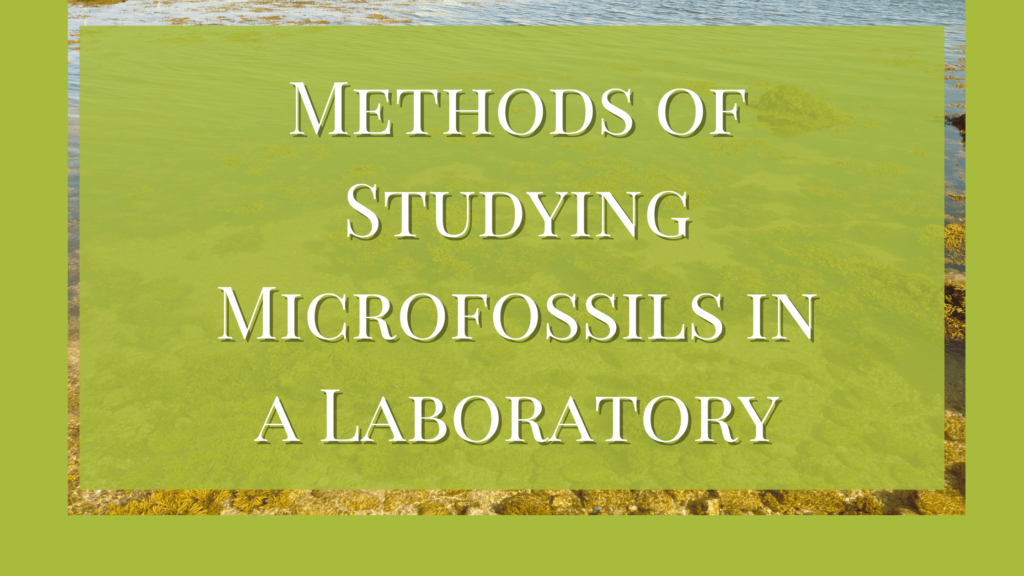Microfossils refer to the tiny remains of microbes, animals, and plants. Although they are a heterogeneous group of fossils, they are studied under a single discipline. They are not grouped based on any of their characters. Instead, they are all classified into one group based solely on their size.
Both new techniques and the improvement of old methods have wrought a revolution in the interpretation of fossil plants. Here are some of the popular methods used in labs to study microfossils.
Ground Thin Section Technique
The thin section of microfossils is prepared in the following manner.
- A small portion of the specimen is ground smooth on one surface. This surface is cemented to a glass slide using Canada balsam or thermoplastic resin.
- With the help of a lapidary’s saw (stone cutter) or similar equipment, as much as possible the specimen is cut away, leaving a moderately thin slice adhering to the slide.
- The section is then ground down on a revolving lamp with an abrasive until translucent.
- When the material is sufficiently thin, the section is sealed with a cover glass and is thus permanently mounted.
Peel Technique or Film Technique
This technique is useful for taking a series of sections from a petrified microfossil specimen. There are two steps involved in this technique- selective maceration (etching) of the surface to be peeled and compounding of a plastic colloidal mixture that will give an exact transfer of the structure of the fossil, upon setting.
The steps of this procedure are given below.
- Grind and smooth (not polish) the surface of the material.
- Etch the surface with a suitable mineral acid (commonly used hydrochloric acid).
- Wash gently with running water, careful not to touch or agitate the etched surface.
- Air dry the etched surface.
- Cover the etched surface with a solution of nitrocellulose, via the pouring method.
- Allow this thin film to dry for at least 8 hours.
- Peel the film from the matrix.
This resultant film will be a thin transfer. Sections of microfossils as thin as 0.5 to 1.0 microns have been measured thus far. The thickness refers to the fossil structure and not the embedding nitrocellulose.
The translucency of such preparations is much superior to that of the ground-thin technique sections. Here, the quality can be improved by the elimination of soluble minerals and insoluble clay materials.
To obtain maximum optical clarity and permanence, the film should be mounted in balsam or damner or a standard non-corrosive glass slide.
Maceration Technique of Studying Microfossils
- Slowly macerate the specimen in a solution made of equal parts nitric acid, hydrochloric acid, and water. Maceration should continue from 3 days to 7 days. Some types of matrix require longer periods and a change of fresh solution.
- Wash the specimen gently in running water for 4 hours or immerse it in water for 6 hours with at least four changes of water.
- At this stage, the matrix should be tested for softness using a fine needle. If it is soft or somewhat mushy and the specimen has loosened along the edges, it should be easier to lift the specimen. Remove the specimen gradually by prying gently around the periphery, working a little at a time.
- When the acid maceration is complete and it is removed, the specimen is placed in a 3% sodium hydroxide or 5% ammonium hydroxide solution. Gradual dissociation of the lumic constituents occurs with concomitant cleaning. Experience will indicate how long alkalization should be continued, Two to 10 minutes is usually sufficient but in some cases, 8 hours is not excessive.
- The specimen is then transferred, manually, using forceps or a lifter, to a shallow water crystal. Washed repeatedly with water and then covered with a 50% solution of ethyl alcohol. After 5 minutes in this solution, the specimen will be dehydrated gradually by successive changes of 70%, 85%, 90%, 95%, and absolute alcohol.
- Following immersion in xylol for one minute, the specimen is placed on a microscope slide, wetted with a drop of xylol, and permanently sealed with a cover glass.
Translucency can be increased by a rinse in benzene between steps 5 and 6, as mentioned above.
Microtome Technique
Microtomy is used for compression microfossils.
- Here, the specimen is treated with hydrofluoric acid and potassium chloride to demineralize or remove the minerals.
- It is then treated with a mixture of equal parts of 95% alcohol and phenol.
- Later it is embedded by the celloidin method or mounted in paraffin.
- Finally, this embedded material is cut into thin sections.
X-ray Technique
X-ray photography of the microfossils is used to study some of the overlooked parts of the specimen. Calcified seeds from coal balls are studied using this method. The radiography of the specimen can reveal portions of seeds from the coal ball, its outline, and vasculature with more accuracy.
Transfer Techniques
The transfer technique is used for the microfossils of plant parts where maceration is not successful. This technique helps get the fossils from the rocky particles. Specimens of pollens, spores, cuticles, etc are studied using this technique. Three methods could study delicate plant specimens adhering to the rocks.
- Ashby Cellulose film transfer: This was proposed by Lang in 1926. Here the part of the rock where the fragments of the specimen are adhered will be coated with a peeling solution like cellulose acetate. When the peel solution dries, the rock portion is carefully removed by cutting and the mineral remaining are removed by immersing the specimen in 25% hydrofluoric acid.
- Balsam Transfer Method: This method was proposed by Beck in 1955 where the microfossils of delicate organs from the rocks are trimmed, dipped, and pressed in balsam and taken on a glass slide with the specimen touching the balsam. The slide is later covered with wax coating by dipping it in wax solution. This is then treated with hydrofluoric acid which removes minerals from the rock while the specimen is affixed to the glass slide and protected by the wax coating.
- The Abbott Transfer Method uses nail polish or varnish to coat the specimen. When the peel hardens it is peeled off to show a variety of display specimens.
References
W C Darrah, 1951, The Materials and Methods of Paleobotany, The Paleobotanist, p. 148.





Thanks to my father who informed me regarding this web site, this blog is genuinely amazing.